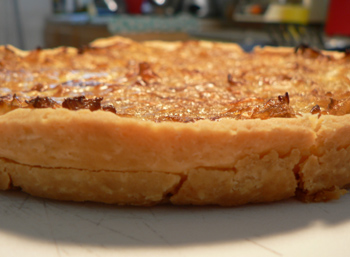 How can you mend a broken tart?
How can you mend a broken tart?
And here I thought you needed cold butter to make pie crust. Not so, according to numerous recipes, such as the one I tried this weekend, from Pierre Hermé’s Larousse des desserts. Why am I always trying so hard to keep butter ice cold? I clearly have a lot to learn about crust, and how the different ingredients and their temperatures affect the finished product.
I used Hermé’s crust to make my favorite onion tart, and it almost went off without a hitch. The crust comes together easily, which is no surprise considering the outrageous amount of butter in it.
190 grams butter (about 13 tablespoons), cut into small pieces, at room temperature
5 grams salt (about 1 teaspoon)
5 centiliters cold milk (slightly less than 1/4 cup, or slightly more than 10 teaspoons)
250 grams flour (2 cups)
I’m translating this from the French. Put the butter in a mixing bowl and smash it around with a wooden spoon. Dissolve the salt in the milk, and then mix it in as well as you can with the butter using the wooden spoon. Sift the flour into a bowl, and add it to the butter in stages, en la versant en pluie, trying to not work the dough too much.
Once the flour is somewhat incorporated, pour the mixture onto a work surface and make the dough by hand (I like to use my hand and a plastic scraper). Crush the dough against the table with the heel of your hand to make it smooth. It comes together very quickly. Split it in two, wrap it in plastic, and refrigerate for at least an hour. I put one half of the dough in the freezer for a future tart.
All of this went fine, and rolling out the dough was easy too. It was in pre-baking that I ran into trouble. After 15 minutes of baking under beans, I took it out to have a look, and the edge of the crust had shrunk considerably. In fact, it practically disappeared, leaving me with a flat crust. I used the trimmings I had leftover (which were intended for cheese sticks!) and made a new rim, which stressed me the hell out, although it did work in the end. You can see below where the crust broke—look how low the original is, and how much height I had to add. After another fifteen minutes of pre-baking, I added my well-caramelized onions and my custard mixture (one egg, 1/4 cup cream, 1/4 cup milk, salt, pepper, nutmeg), and baked it for about 25 minutes, until it was well browned.

The crust is extremely good: flaky, buttery, and tender. When I use the second half, I’ll really bulk up the sides and make them as tall as I can before pre-baking. Otherwise, this bizarre crust is a keeper.

Comments
This reminds me of Jacques Pepin’s mother’s recipe for her apple tart ; that uses softened butter, too, in addition to an egg. It’s easy to work with and is very tender. You’d think the rest in the refrigerator would have relaxed the gluten enough so that your pastry wouldn’t have shrunk in the oven like that; maybe next time a lighter hand with the kneading.
Have to say, this title is adorable.
I was walking through the library and I had a pop music pun inspiration regarding lindy’s lunch challenge. But I’ve forgotten and it won’t come back to me!!! Argh!! I’ve been driving myself crazy.
Doughs like this have always given me trouble too, exactly like you’ve described, they slump down in the pan during the pre-bake. I was thinking it was all the butter, but it might also be something about the technique. Your tart looks tasty, though.
Did you possibly stretch the pastry at all when you were placing it in the tart pan? Maybe as you were lifting it up? Dorie Greenspan warns that if you do that, the crust will shrink back to the pre stretched shape.
Looks great!
Thanks, everyone, for your comments! I had the same thought as Mary, that the high butter content resulted in the slumping. The dough spent the night in the fridge, so it was as rested as can be. I also rolled it out quickly, and I didn’t stretch it, as far as I know. There was no springing back during the rolling or insertion. It’s the first time it’s happened to me, and I’m curious to see what happens with the second half of the dough.
Leland,
I looked up some things about tart crusts in my Larousse gastronomique and some other cooking books (which I keep at work, so that’s why I couldn’t get to it until today). It seems that the room temperature butter and the fraisage (smooshing the dough on the work surface with the heel of the hand) have the express purpose of making a dough that is not flaky like American pie doughs, so you want the butter to become incorporated, but the smooshing part (if you can get someone to show you who knows how to do this, even better) serves to make long strands out of the butter and flour rather than little lumps of butter flour mixture like in an American pie crust. In any case, you want some structure to this crust. As we were imagining, the butter will cause it to fall, so you want some of the glutens in the flour to be stiff, so the long overnight rest is also partially to blame. Also, you need to make sure that the oven is at the proper temperature from the beginning (pre-heat for sure, and compare cooking times of French and American recipes). I won’t have time to try out your recipe for a few days, but I am now intrigued enough to look into this further. Maybe we need a “Year in Pies and Tarts” blog like the “Year in Bread” one.
Thanks for all the info, Mary! I did use the fraisage method as taught in class. How interesting that the long rest may have harmed the dough; I’m going to read more of the book tomorrow and see if Hermé cautions against it.
I’d love to make this recipe as it seems sinfully delicious, but why is this one in European measurements when all the other recipies on this blog are in American measurements?
Thanks for pointing that out, Margaret, and sorry for any confusion. I just added American measurements as close as I could convert them. Good luck with the crust!
Dearie, a much better title would have been, “Where do broken tarts go?”. Whitney needs our support during these troubled times.
Carly: Quit playin’ games with my tart.
Thanks Leland! I see this as a great Sunday brunch by the pool item!
Add a comment